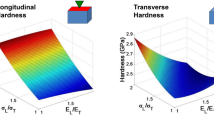Abstract
The bahavior of powder materials is considered whose properties are sensitive to a third invariants of stress and strain rate. Nonlinear relationships between stress and strain rate tensors for isotropic compactable material are found. Limitations on the material parameters of the model that provide correct determination are formulated. Estimates of axial and radial stress during compaction with a rotating die are presented within the model developed. It is established that three-invariant models describe more accurately the reduction in operating parameters with an increase in rotation rate than models containing the first two variants.
Similar content being viewed by others
REFERENCES
A. Freidental and H. Geiringer, Mathematical Theories of an Inelastic Solid [Russian translation], Fizmatgiz, Moscow (1962).
A. Sawchuk and P. Stutz, “On formulation of stress-strain relations for soils at failure,” Angew. Math. Phys., 19, No. 5, 770–778 (1968).
M. B. Shtern, “Constitutive equations for plastic porous bodies, ” Poroshk. Metall., No. 4, 17–21 (1981).
E. Pavier and P. Doremus, “Triaxial characterization of iron powder behavior, ” Powder Met., 42, No. 4, 345–352 (1999).
V. Z. Midukov and V. D. Rud', “Experimental verification of the basic hypotheses of plasticity theory for porous bodies, ” Poroshk. Metall., No. 1, 6–17 (1982).
I. C. Sinka, A. C. F. Cocks, and J. H. Tweed, “Constitutive data for powder compaction modelling, ” J. Eng. Mat. Techn., No. 1, 241–259 (1999).
A. L. Gurson, “Continuum theory for ductile rupture by void nucleation and growth. I. Yield criteria and flow rules for porous ductile media, ” Trans. ASME J. Eng. Mat. Techn., 2–15 (1977).
M. B. Shtern, “On the constitutive potential for powders and porous bodies, ” in: Mechanics of Granular and Porous Bodies, N. A. Fleck and A. C. F. Cocks (eds.), Kluwer Academic Publ., Dordrecht (1997).
P. Mosbah, Jun Kojima, S. Shima, and H. Kotera, “Influence of the third invariant on powder behavior during compaction, ” Proc. Int. Workshop on Modelling of Metal Powder Forming Processes (Grenoble, 21–23 July, 1997), Grenoble (1997).
V. Z. Midukov, Study of the Features of Plastic Deformation for Materials with Irreversible Volumetric Compressibility, PhD Thesis [in Russian], Tomsk (1975).
M. B. Shtern and A. C. F. Cocks, “The structure of constitutive laws for the compaction of metal powders, ” in: Recent Developments in Computer Modelling of Powder Metallurgy Processes, IOS Press (2001).
Author information
Authors and Affiliations
Rights and permissions
About this article
Cite this article
Shtern, M.B. Effect of a Third Invariant on the Properties and Structure of Constitutive Relationships for Powder Materials. Powder Metallurgy and Metal Ceramics 42, 329–335 (2003). https://doi.org/10.1023/B:PMMC.0000004151.45288.60
Issue Date:
DOI: https://doi.org/10.1023/B:PMMC.0000004151.45288.60




